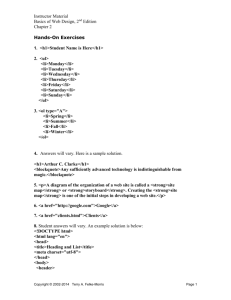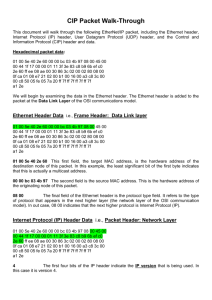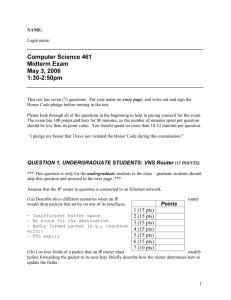Lecture 14
advertisement
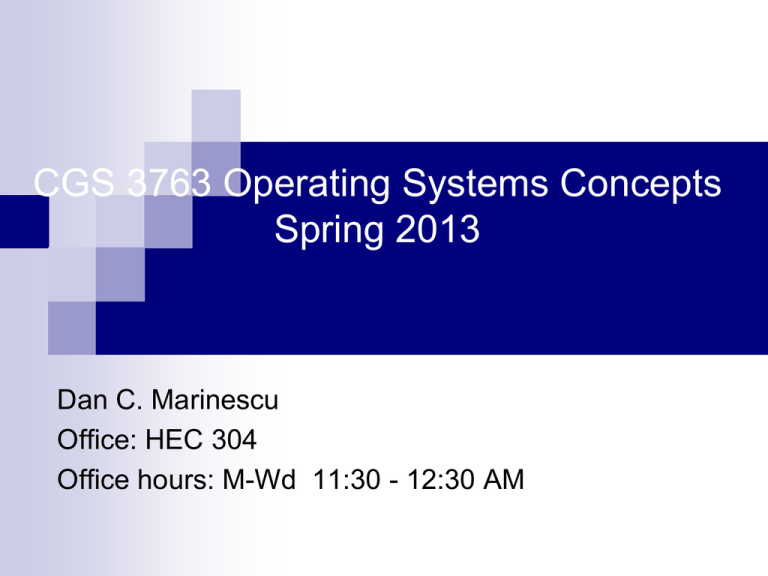
CGS 3763 Operating Systems Concepts Spring 2013 Dan C. Marinescu Office: HEC 304 Office hours: M-Wd 11:30 - 12:30 AM Lecture 14 – Friday, February 8, 2013 Last time: Today: Networking concepts Solutions to HW1 Student questions for week 4 More network concepts Client-server systems Remote procedure call Next time Shared memory systems Pipes Reading assignments Chapters 3 and 4 of the textbook Chapters 3 and 4 textbook slides Lecture 13 2 Solutions to HW1 1.2 What are the main differences between an OS for a mainframe and one for a PC? Mainframe: a. more sophisticated resource management policies; b. additional functionality, e.g., it has to support accounting; c. enhanced security. 1.3 What are the four steps involved in the execution of an instruction on a stored-program computer? Instruction fetch from the address pointed at by the PC (Program Counter) into the IR (Instruction Register). Instruction decode. Instruction execution. Write back the results Lecture 13 3 Solutions to HW1 3 Several users share a system in multiprogramming and time-sharing environments and this can result in security problems: (a) List two such problems; (b) Can we ensure the same level of security in a time-shared system as in a dedicated machine. Explain your answer. a. Security and privacy; unpredictable execution time. b. Probably not, since any protection scheme devised by humans can inevitably be broken by a human, and the more complex the scheme, the more difficult it is to feel confident of its correct implementation. Lecture 13 4 Solutions to HW1 1.14 What resources must be managed carefully in the following settings: (a) Mainframe of minicomputer systems; (b) Workstations connected to servers; (c) Handheld computers. Mainframes: memory, CPU, primary and secondary storage, network. Workstations: memory,CPU, network Handheld computers: power consumption, memory resources, display, RF (Radio Frequency) subsystem for wireless communication. 1.15 Under what circumstances would a user be better off using a time-sharing system rather than a PC or a single-user system? (a) When the amount of computing resources (CPU cycles, primary and secondary storage) is considerable. (b) When the problems requires a collaborative effort of several users. Lecture 13 5 HW1 solutions 1.21 How are network computers different from traditional PCs? Describe some usage scenarios in which it is advantageous to use network computers. A network computer has limited resources and relies on systems accessible via the Internet for data storage and for computing; its price is low. The OS of a network computer supports a small number of functions. Chromebook is an example of a network computer see http://www.google.com/intl/en/chrome/devices/#foreveryone-promosamsung Typical usage scenario: Web access, Email access. Lecture 13 6 Student questions Jan 30th Wednesday: More on the fork() or exec() commands. Better explanation of pipelining and what it is. Where does the PCB come into play? Explain further the concept of an interrupt. What is an interrupt vector? What determines which process has more priority over another process? What is the purpose of the program counter? Why do we need to know this? Lecture 13 7 Student questions Feb 1st Friday: What is the main difference between independent and cooperating within a system? RISC/CISC Architecture: what exactly are these two architectures? What is an example of CISC machine and where are they used? What is the advantage or disadvantage of these versus the standard RISC? Further explain branch execution. Explain in greater detail of a process creation and what it is used for? What is a Producer-Consumer Problem? What is a flag/condition code, where does it come in place? What are the major differences between layered and modular systems? Lecture 13 8 Peer-to-peer communication Host Host Application Layer (Message) Application Layer (Message ) Network Transport Layer (Segment) Network Layer (Packet) Data Link Layer (Frame) Physical Layer Transport Layer (Segment) Router Router Network Layer Network Layer Network Layer (Packet) Data Link Layer Data Link Layer Data Link Layer (Frame) Physical Layer Physical Layer Physical Layer Streams of bits encoded as electrical, optical, or electromagnetic signals Lecture 13 9 Local and wide area networks Wide Area Network Router Router Network Layer Network Layer Data Link Layer Physical Layer Data Link Layer Physical Layer Host Host Application Layer Application Layer Transport Layer Transport Layer Network Layer Local Area Network Bridge Data Link Layer Hub Physical Layer Physical Layer Data Link Layer Physical Physical Layer Layer Local Area Network Bridge Data Link Layer Physical Layer Lecture 13 Network Layer Hub Data Link Layer Physical Layer Physical Layer 10 Encapsulation/ de-capsulation Application Header Transport Header Network Header Message Segment Packet Data Link Header Frame Encapsulation at the sender Data Link Header Frame Network Header Packet Transport Header Segment Application Header Message Decapsulation at the receiver Lecture 13 11 IPV4 and IPv6 datagrams 0 16 8 version hlen ToS flags fragment identifier time to live 31 packet length (bytes) upper layer prot 12-bit fragment offset header checksum 32-bit source IP address 32-bit destination IP address options (if any) 0 version Payload 16 8 31 flow label priority payload length (bytes) next header hop limit 128-bit source IP address 128-bit destination IP address Payload Lecture 13 12 Multiplexing, de-multiplexing P1 P2 P3 P1 P4 P2 P3 P4 Sending side Receiving side Lecture 13 13
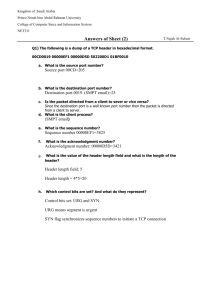


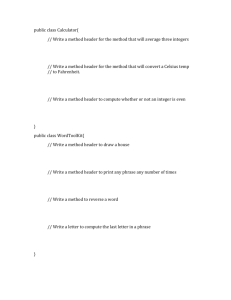

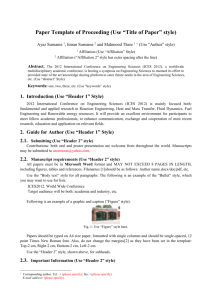
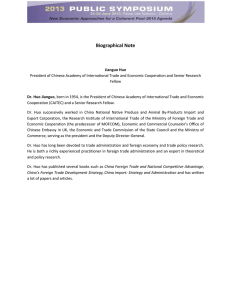
![Quality of Service [Autosaved]](http://s2.studylib.net/store/data/005612920_1-669e91c219b94acbd910775405848f1b-300x300.png)
